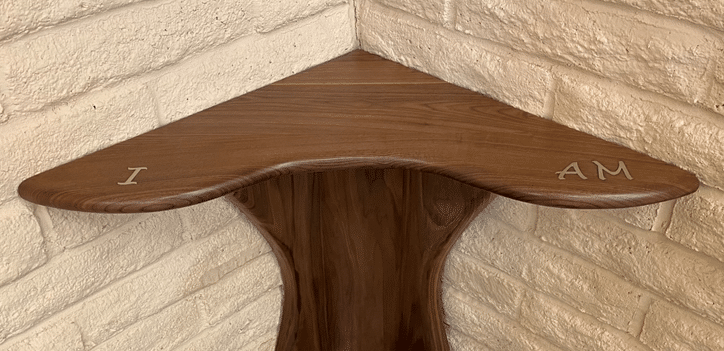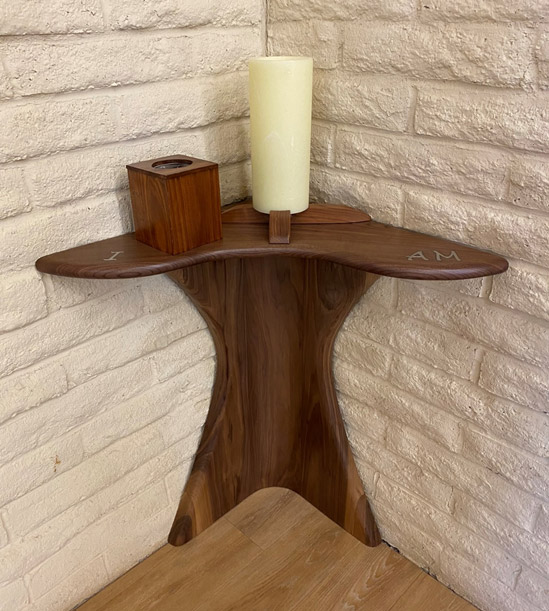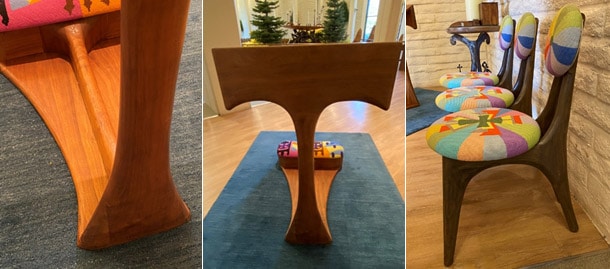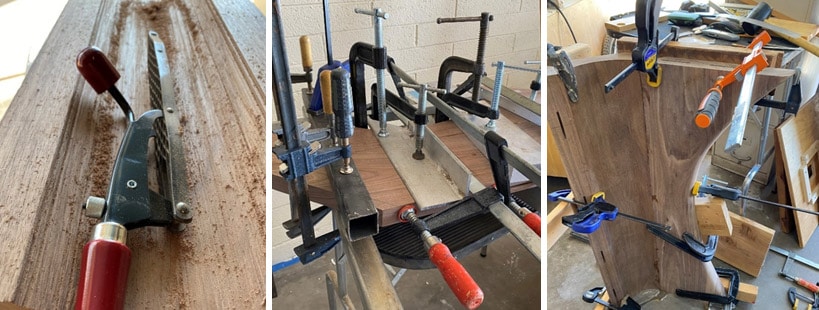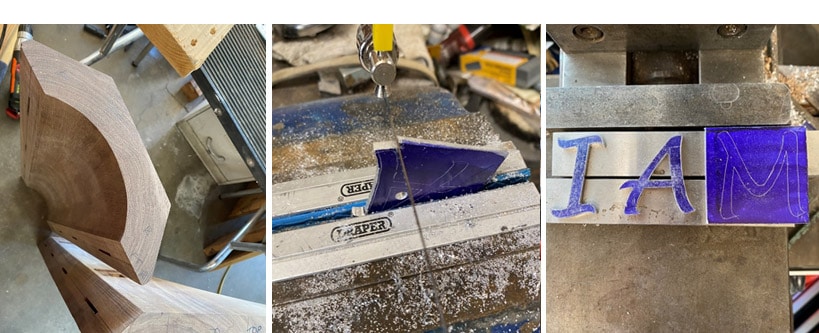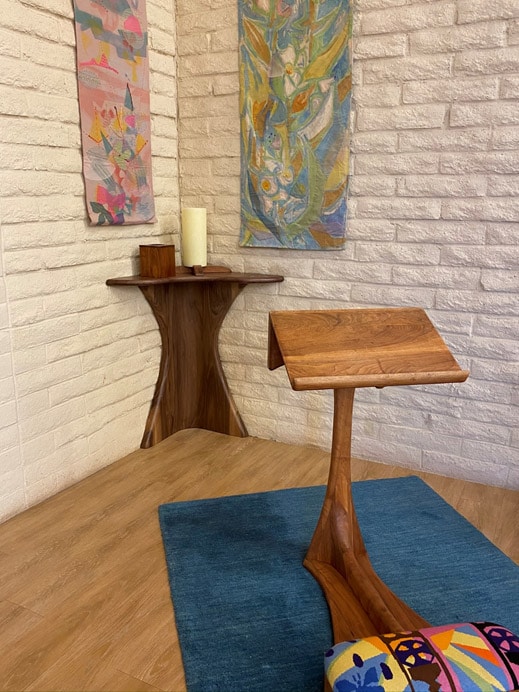The prayer station table memorial
The table is given to the Glory of God in loving memory of Judy Echols
The prayer station has been created in a corner of the Sanctuary, to the side of the altar, to be used during the Eucharist for the benefit of those seeking to receive intercessory prayers. The prayer station corner table will serve along with the other liturgical furnishings (the Prie Dieu, the wall banners, and the floor covering) to create a defined space for prayer.
The design provides a convenient surface at the prayer station, correctly sized for the candle holder with candle, tissue box, and anointing oil.
The I AM element of the design
The I AM element of the table design is intended to bear witness to the profound use of I AM throughout the Bible and serve as a reminder of the boundless Presence of God during the time of prayer. As the I AM is in the table top, it does not become visible until one is close to the table, as during the time of receiving prayers.
The idea of incorporating I AM into the design results from the TAEHS forum presentations on I AM during the Fall of 2019 by Fr. Jim and the lessons on I AM in the Gospel of John TAEHS sessions.
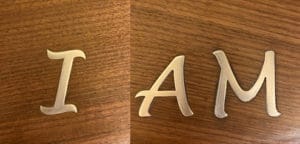 The I AM is intended to be a visual reminder, with flowing letters, like the flowing of the Spirit. The letters are raised slightly above the surface so that one can also have a tactile response by running one’s fingers over them.
The I AM is intended to be a visual reminder, with flowing letters, like the flowing of the Spirit. The letters are raised slightly above the surface so that one can also have a tactile response by running one’s fingers over them.
The I and AM are separated across the tabletop from wall to wall as a visual reminder that God spans the dimensions of space – from Alpha to Omega.
I AM is found throughout the Old and New Testaments:
In the Old Testament:
Moses encounters God in the burning bush in Exodus 3:1-15. Moses wanted to have a name for God when he returned to the Israelites to tell them, “The God of your ancestors has sent me to you,” and they ask me, “What is his name?” God said to Moses, ‘I AM WHO I AM.’ ‘Thus, you shall say to the Israelites, “I AM has sent me to you.” ‘ God responds as one who cannot be named. Moses experiences God’s presence, yet God remains a mystery that transcends all. All things emanate from God.
In the New Testament:
The gospel of John contains the majority of the I AM sayings of Jesus. The synoptic gospels contain none of these sayings of Jesus. It is in these sayings that Jesus offers glimpses into the nature of God to those who can hear Him. The I AM sayings reveal who Jesus is in profound ways.
The seven I AM sayings with a predicate in the Gospel of John:
I am the bread of life (6:35, 48, 51)
I am the light of the world (8:12)
I am the gate (10:7, 9)
I am the good shepherd (10:11, 14)
I am the resurrection and the life (11:25)
I am the way, the truth and the life (14:6)
I am the true vine (15:1,5)
There are two additional verses:
I am the one who bears witness concerning myself (8:18)
I am the one from above (8:23)
These are the “I am” sayings of Jesus that are known as sayings with a predicate. Jesus says “I am” followed by a qualifier.
There are also a number of “I am” sayings where Jesus only says “I am.” In these instances, Jesus is saying that he is God or is one with God, as God said to Moses in Exodus. All of this is intended to say that God has created us to be in a relationship with Him, yet God remains a mystery.
Additional “I am” sayings, without a predicate:
The woman said to Him, “I know that Messiah is coming” (who is called Christ). “When he comes, he will proclaim all things to us.” Jesus said to her, “I am, the one speaking to you.” (4:25-26)
I am; do not fear (coming to the disciples, walking on the water). 6:20
I told you that you would die in your sins, for you will die in your sins unless you believe that I am. (8:24)
When you have lifted up the Son of Humanity, then you will realize that I am (8:28)
I tell you this now, before it occurs, so that when it does occur, you may believe that I am. (13:19)
They answered, “Jesus of Nazareth.” Jesus replied, “I am” . . . They stepped back and fell to the ground. (18:5-6)
In John 8:58, Jesus, speaking to the Jews, says “Very truly, I tell you, before Abraham was, I am.”
To quote the TAEHS Gospel of John Session Ten group study introduction, written by Fr. Jim, “Eternal Life is not defined by these “I am” saying, but the experience of eternal Life is described by them, Thus, the experience of eternal Life is described by such metaphors as light, bread, being shepherded, the doorway into belonging in God’s fold, etc. These “I am” sayings spring from the face-to-face gaze that is the beginning of the prologue of John and the word made flesh living “into the bosom of the father” that is the end of the prologue. The prologue, therefore, explains or helps us understand how it is that Jesus, the Word made flesh, can claim to be “I am.” And the “I am” sayings are the heart of Jesus’ revelation of who God is, especially who God is in relationship to humanity.”
In the book of Revelation, Jesus says “I am the Alpha and the Omega.” (Rev. 22:13)
Design Considerations
The design follows the graceful, curved lines of the Prie Dieu and other liturgical furnishings. All curved edges are radiused across their full thickness to enhance the aesthetics of the piece.
The top is at the correct height to work with the height of the Prie Dieu and also be correct for the placement of the candle, anointing oil, and tissue box (best height found to be 38 inches after measuring several items in the Sanctuary).
It is custom fit into the corner accommodating the slump block irregularities.
It is constructed of wood similar to the wood used for the other liturgical furnishings (walnut).
It is solidly attached to the wall so that it can’t be moved around.
It is shaped to fit into the corner so as to not impede the movement of the people using the prayer station and a small footprint for times when Sanctuary items are moved about.
Metal inlay of I AM into the wood top surface is reminiscent of the inlay of Chi Rho in the altar. The I AM differs from other visual representations of God, in that it is not a symbol, rather words alone that one can easily connect with.
Existing Liturgical Furnishings
Photos of the existing liturgical furnishings, giving an idea of the shapes and designs. The graceful curves are echoed in the I AM table design.
Installation On The Wall
 The table is anchored to the wall by a masonry screw on the south wall that fits into a machined, slotted plate screwed to the rear of the table. The screw head can slide vertically in the plate slot, allowing the table to slide vertically enough to accommodate different thicknesses of a floor covering placed under the table. The plate also slides horizontally, so that the table can be moved up against the east wall.
The table is anchored to the wall by a masonry screw on the south wall that fits into a machined, slotted plate screwed to the rear of the table. The screw head can slide vertically in the plate slot, allowing the table to slide vertically enough to accommodate different thicknesses of a floor covering placed under the table. The plate also slides horizontally, so that the table can be moved up against the east wall.
When the table rests on a floor covering it is important that the floor covering not be pulled out from under the table. Instead, the table needs to be slid away from the east wall about ¼ inch and then lifted straight up so that the floor covering can be removed.
To remove the table from the wall, raise it straight up about ½ inch so that the masonry screw head aligns with the round opening in the slot on the mounting plate and pull the table away from the wall. See the photo (left).
Finish of the wood
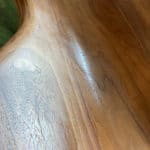 The walnut is finished with a semi-gloss polyurethane, without the use of stain. Over time the walnut color will lighten from exposure to UV light. Applying a wood preservative oil to the finish will not serve a purpose, as the wood is protected by the polyurethane layer.
The walnut is finished with a semi-gloss polyurethane, without the use of stain. Over time the walnut color will lighten from exposure to UV light. Applying a wood preservative oil to the finish will not serve a purpose, as the wood is protected by the polyurethane layer.
Construction photos
Prayer Station with Lee Porzio banners used for illustration of how the prayer station will look
The design was motivated not only by the functional need for a table that serves a basic function but also by the impact of I AM throughout the Bible, as taught in the Gospel of John TAEHS forums by Fr. Jim. The hope is that it may serve to the Glory of God for many years!
